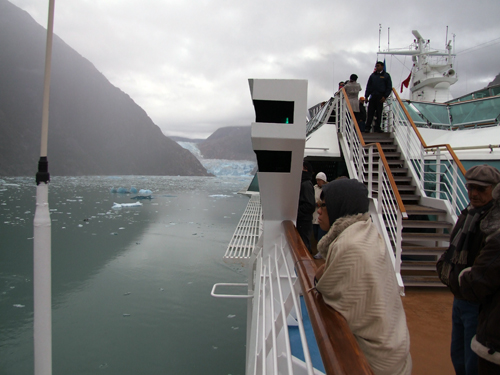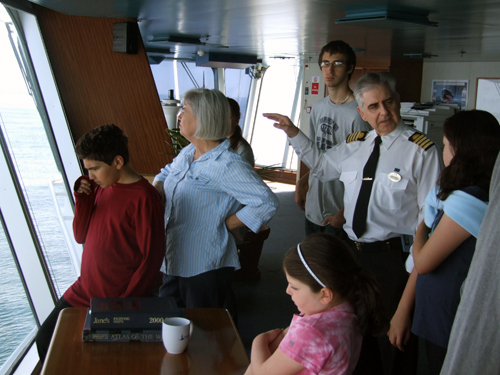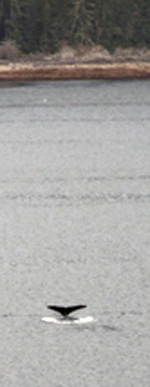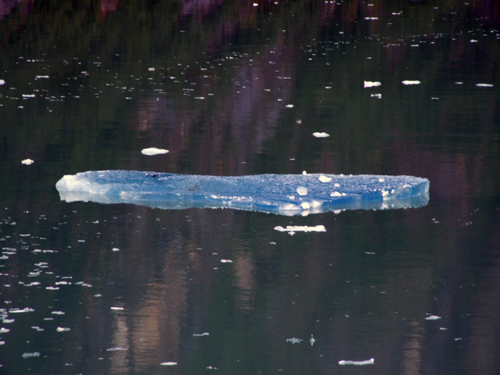
By Donald H. Harrison
TRACY ARM, Alaska – Less than a week after Sea Princess visited this fjord south of Juneau, an apartment building-size piece of the Sawyer Glacier crumbled into the water, amazing and then horrifying passengers aboard a small excursion boat. The “calving” of the glacier—as can be seen on YouTube—was a spectacular sight to behold, but it also was the cause of a large wave that so rocked the excursion vessel that one woman fell onto the deck, reportedly breaking a leg.
While I don’t know the exact dimensions of the excursion vessel, it probably could be lifted by crane onto a deck of the Sea Princess, just as the ship’s lifeboats and tenders are. Sea Princess is 77,499 gross registered tons. It is slightly more than 857 feet long, and 105 feet wide, and extends nearly 27 feet below the water line. Additionally it has a sophisticated stabilizer system. So whereas passengers may have felt that wave from the calving glacier, it’s unlikely they would have felt it so violently.

Captain Martin Stenzel recently was asked by a passenger what would happen if a whale were sighted on the port (left) side of the ship, and all 2,000 of the passengers were to run over to that side to observe. Would the ship even tip? Not very likely, responded Stenzel. In land terms the ship weighs about 50,000 tons. “The total weight of the passengers is about 200 tons,” he said.
On the August 5 morning that Sea Princess visited Tracy Arm, the waters were calm, with barely a wave to break the serenity. It was as if we were floating through a picture postcard as naturalist Alan Cortash narrated over the ship’s loudspeakers some of the sights that passengers who went out on deck, tuned in their TV set in their cabin, or lingered over coffee in the Horizon Court were able to see.
Tracy Arm, we learned, was named for Benjamin F. Tracy, who served as secretary of the Navy under President Benjamin Harrison. During the U.S. Civil War, Tracy had been awarded the Medal of Honor for gallantry during the Battle of the Wilderness in Virginia. The official name for this glacier’s home is Tracy Arm-Ford’s Terror Wilderness. Ford was a Navy crewmember who paddled into the area in 1899 and was trapped for six hours in tidal surges similar to those experienced by passengers on that excursion boat.
Cortash, a former dolphin trainer at a Florida marine mammal park, had been narrating nature excursions along the West Coast from San Diego to Alaska for decades. He directed our attention to the various kinds of ice floating in the 26 mile long fjord and explained how to differentiate them. “Large chunks are called ‘icebergs.’ Chunks of ice about 15 feet are called ‘Bergy Bits,’ a real scientific term. And ice about 3 feet long are called ‘growlers,’ probably because in the 1700s when ships rubbed against them it seemed like they were growling.”
Another explanation for the name holds that when air escapes from melting ice it makes a sound similar to a growl.
Cortash noted that the Sawyer Glacier has been retreating, explaining that more of it calves each year than is added to by snow fall. As a result, the glacier seems to be “retreating” but, so that no one should be confused, Cortash emphasized that ice flows only in one direction, downhill, and never flows backward.
He pointed to a chunk of ice—it must have been a “bergy bit” floating in the fjord. It was blue in color. He explained that the crystalline structure of glacial ice absorbs all colors except blue – thus the blue color remains evident. Eventually, as the ice floats in the fjord’s waters, the crystalline structure will break down, and that same chunk will appear white.

Cortash directed our attention to the U-shaped landscape mountain scape around the fjord. He said the tops of these mountains once were jagged and pointed, but today they are ground down and rounded. This process occurred about 20,000 years ago, when almost all this area was under ice.
The advancing glaciers scoured the soil, leaving very little of it for trees to grow in. Thus, the root systems of the trees on the mountainside today are very shallow; they spread out, rather than delve deep, because solid rock prevent the roots from growing straight down. The roots of the various trees become intermeshed.
